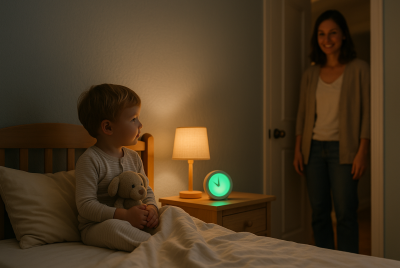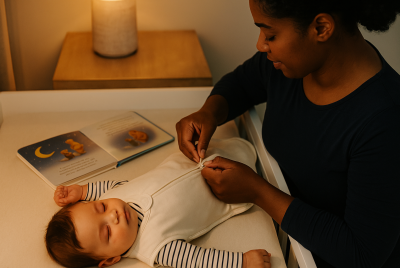When to Move Baby to Own Room: A Calm, Evidence-Based Guide
We may earn a commission for purchases made using our links. Please see our disclosure to learn more.
You’re staring at the bassinet and wondering if tonight’s the night. You crave better sleep, privacy, and a rhythm that doesn’t revolve around tiptoeing past a tiny human. But you also want to keep your baby safe—full stop. If you’re asking when to move baby to own room, you’re in the right place.
In this friendly guide, we’ll cover what experts say, signs your baby might be ready, when to wait, and how to make the transition gentle and safe. You’ll also find gear picks that genuinely help, research you can trust, and practical scripts for those first few nights.
Affiliate note: I may earn from qualifying purchases at no extra cost to you.
The short answer: when to move baby to own room
Most pediatric bodies recommend room-sharing (not bed-sharing) for at least the first 6 months, with many encouraging up to 12 months as a protective layer against sleep-related risks. After about 6 months—if your baby is healthy, thriving, and you’ve set up a safe sleep space—many families start transitioning to a separate nursery. (We’ll break down the “why” and the research below.)
Bottom line: If you’re weighing when to move baby to own room, the typical decision point often lands between 6–12 months, adjusted to your baby’s needs, your home setup, and your own wellbeing.
What “ready” looks like: practical signs by age
- 4–6 months: Longer stretches of sleep, fewer night feeds, consistent bedtime routine.
- 6–9 months: Rolling both ways, strong startle control, predictable naps, safer body control.
- 9–12 months: Separation awareness increases; a calm, predictable nursery can help.
Ready indicators
- Your baby’s night feeds have reduced and weight gain is steady.
- You can lay baby down drowsy but awake, and they settle with brief support.
- The nursery meets safe sleep guidelines (crib/pack-n-play, firm mattress, fitted sheet, no soft items).
Reasons you might wait a little longer
- Medical considerations: Prematurity, reflux, respiratory issues, or other clinical factors.
- Feeding needs: Frequent night feeds or weight gain concerns.
- Parental wellbeing: Postpartum recovery, anxiety, or simply not feeling ready.
- Housing realities: Shared rooms, multi-family households, or limited space.
If any of the above applies, talk with your pediatrician and move on a timeline that feels safe and supportive.

Safety first: your pre-move checklist
- Crib safety: Firm mattress, tight sheet, no pillows/bumpers/blankets/toys.
- Sleep position: Always back to sleep.
- Room temp & airflow: Keep comfortably cool; avoid overheating.
- Light & sound: Dark room + consistent white noise can reduce startles.
- Monitor: Reliable audio/video monitor for reassurance (not a medical device).
- Cords & furniture: Nothing within reach of the crib; anchor dressers/lamps.
- Routine: Same bedtime steps you used in your room—familiarity is soothing.
Step-by-step transition plan (gentle but effective)
Night 1–3: Introductions
- Start with daytime crib naps in the nursery.
- Do the full bedtime routine in the nursery, then consider one parent sitting nearby for a brief reassurance window.
- Use the same white noise you use in your room.
Night 4–7: First nights in the nursery
- Move the full night sleep to the nursery.
- Offer brief check-ins or a calm voice through the monitor if needed.
- Keep responses short, consistent, and sleepy.
Week 2: Stretching confidence
- Gradually space out check-ins (if you’re using them).
- Keep wake windows appropriate to age.
- Review the environment: too bright? Too hot? Too quiet?
Feeding, regressions, and realistic expectations
- Night feeds: You can still feed overnight in the nursery. Keep lights dim, voices low, and settle baby back in the crib.
- Regressions: 4-month and 8–10-month regressions can happen. Stay consistent; it’s temporary.
- Teething/illness: If baby is uncomfortable, offer comfort—but return to your routine once they’re better.

Room-sharing vs. own room: quick pros & cons
Room-sharing pros
- Protective in early months
- Easier feeds and quick soothing
- Peace of mind during the newborn stage
Room-sharing cons
- Light/noise disruptions (both directions)
- Harder to establish independent sleep after a certain point
Own room pros
- Quieter, darker sleep environment
- Helpful for long-stretch sleep consolidation
- Restorative for parents, especially if one is an early riser
Own room cons
- More walking at night
- Anxiety the first few nights (totally normal!)
- Requires a reliable monitor and safe setup
Small-space and budget hacks
No nursery? No problem. Many families live in studios or share rooms with siblings.
- Define zones: A lightweight room divider or curtain creates a sleep “nook.”
- Portable darkness: Temporary blackout shades are amazing for naps and travel.
- Compact sleep spaces: If you’re still in the newborn phase, a safe, firm mini-bed helps you manage space. Here’s a newborn baby basket guide that walks through safe, compact sleep options and setup tips: gentle guide to choosing a baby basket.
- Keep routines portable: Consistent sound, smell (freshly laundered sleep sack), and lullaby cues travel well.
Nursery setup that supports sleep
- Darkness: Aim for near-pitch black at night and naps.
- White noise: Steady “shhh” masks household noise.
- Temperature comfort: Dress baby in a season-appropriate sleep sack instead of loose blankets.
- Simple is safest: Skip positioners, bumpers, pillows, and plush toys.
- Monitor placement: Angle for a clear crib view; hide/secure cords well away from the crib.
Affiliate product picks to smooth the move (Amazon)
These are practical, parent-loved tools that make the transition easier. Click through for full specs and current pricing.
1) Infant Optics DXR-8 PRO Video Baby Monitor
Why it helps: Clear, lag-free picture without Wi-Fi, so you’re not troubleshooting apps at 2 a.m. 5″ 720p screen, pan/tilt/zoom, and Active Noise Reduction to reduce background hum. 1-year warranty; extendable upon registration.
Features: No-Wi-Fi monitor, ANR, interchangeable lens system.
Pros: Reliable signal, crisp video, easy to use.
Cons: Separate handheld to charge; no remote viewing.
Best for: Parents who want a simple, secure, non-Wi-Fi monitor.
Review snapshot: Parents praise the picture and ANR; occasional complaints about battery life over time.

2) VTech DM221 Audio Baby Monitor
Why it helps: Budget-friendly, long range, and DECT 6.0 clarity for hearing cries without Wi-Fi.
Features: Talk-back intercom, vibration alert, up to 1,000 ft range.
Pros: Affordable, dependable audio.
Cons: Audio-only; battery life is finite.
Best for: Small apartments or parents who prefer sound-first monitoring.
Warranty: 1-year limited warranty.
Review snapshot: Loved for range and simplicity; some wish for rechargeable longevity.

3) Hatch Rest (2nd Gen) Sound Machine & Night Light
Why it helps: Consistent white noise + gentle light = sleepy signals. App scheduling keeps nights boring (in a good way).
Features: Adjustable sounds, dimmable light, routines via app.
Pros: Easy, repeatable sleep cues; grows with toddler “time-to-rise.”
Cons: App reliance isn’t for everyone.
Best for: Families who love automations and a tidy bedside look.
Warranty: 1-year limited warranty (authorized sellers).
Review snapshot: Fans love the app and sound library; occasional Wi-Fi/app quibbles.

4) HALO SleepSack Wearable Blanket (100% Cotton)
Why it helps: Safe warmth without loose blankets; zipper design simplifies sleepy diaper changes.
Features: Breathable cotton; seasonal TOG options.
Pros: Safer than blankets; washable; size ranges.
Cons: You may need different TOGs for seasons.
Best for: Any baby transitioning away from swaddling or who runs cool/warm.
Review snapshot: Parents love the quality and ease; some feedback on sizing and seasonal warmth.

5) NICETOWN 100% Blackout Curtains
Why it helps: Darkness promotes melatonin and reduces early wakes—great for naps and summer evenings.
Features: Thermal insulation, light-blocking drapes in multiple sizes.
Pros: Better sleep environment on a budget.
Cons: Some rooms still need a portable blackout shade for total darkness.
Best for: Nurseries facing streetlights or early sun.
Review snapshot: Rave reviews for blackout effect; occasional notes on length/fit.

Product comparison (at a glance)
| Model | Key Spec(s) | Warranty | Approx Price/Tier | Best For |
| Infant Optics DXR-8 PRO | 5″ 720p, ANR, no Wi-Fi, PTZ | 1-yr (extendable upon registration) | Premium | Secure, no-app video |
| VTech DM221 | DECT 6.0 audio, 1,000 ft range | 1-yr limited | Budget | Simple, reliable audio |
| Hatch Rest (2nd Gen) | App control, light + white noise | 1-yr limited | Mid-range | Routine-loving families |
| HALO SleepSack (Cotton) | Wearable blanket, seasonal TOGs | Varies by seller | Budget–Mid | Safer warmth vs blankets |
| NICETOWN Blackout | Thermal, light-blocking panels | Varies by seller | Budget | Dark, nap-friendly room |
Common mistakes to avoid
- Moving too early without support: If feeds are still frequent and sleep is chaotic, you’ll do more walking and less resting.
- Skipping the environment check: A bright or noisy nursery can sabotage good habits.
- Changing everything at once: Keep bedtime routine, sound, and sleepwear consistent.
- Expecting zero wake-ups: Babies wake. Your goal is faster, calmer resettles.
Research-backed insights (why the guidance differs)
- Why room-sharing helps early on: The American Academy of Pediatrics highlights that room-sharing (not bed-sharing) for at least the first 6 months—and ideally up to 12 months—reduces the risk of sleep-related infant death; some summaries cite risk reductions of around 50%. Recommendations also stress a firm, flat, clutter-free sleep surface.
- Why some families move earlier: A 2017 study in Pediatrics associated room-sharing after the first few months with less infant nighttime sleep and reduced sleep consolidation, alongside more unsafe practices (like moving to adult beds out of exhaustion). This doesn’t erase early room-sharing benefits, but it helps explain why many pediatricians suggest revisiting the plan around the 6-month mark.
How to use this: Pair early-months room-sharing for safety with a gentle, readiness-based transition later in infancy, always maintaining safe sleep practices.

Troubleshooting: if the first nights flop
- Lots of tears? Scale back: try daytime naps in the nursery for 2–3 days, then reattempt nights.
- Multiple night wakes? Check the basics: darkness, white noise, temp, last nap timing.
- Parental anxiety? Place the monitor on your nightstand; pre-set volume and screen brightness so you aren’t checking 50 times.
FAQs
When to move baby to own room if they still wake to feed?
If feeds are brief and your baby settles quickly, you can still move now—do the feed in the nursery and keep everything low-stimulation. If feeds are long/frequent or weight is a concern, consider waiting.
Is a baby monitor enough to keep my baby safe?
Monitors offer awareness, not prevention. Follow safe-sleep rules (firm surface, back sleeping, no soft items), keep cords away, and use the monitor for prompt responses—not as a medical device.
What if my baby sleeps better with me?
Many do in the earliest months. Room-sharing (separate safe sleep surface) helps. If you’re past 6 months and sleep is crumbling, creating a dark, quiet nursery often improves stretches.
Can I move baby during a regression?
You can, but expect slower progress. If you’d rather minimize disruption, ride out the regression 1–2 weeks and then restart your plan.
Do I need blackout curtains and a sound machine?
You don’t need them, but darkness and consistent white noise help many babies connect sleep cycles—especially for naps and during noisy evenings.
Gentle pep talk (and the real bottom line)
If you’re agonizing over when to move baby to own room, remember: you’re not choosing “right or wrong.” You’re balancing safety, readiness, and family wellbeing. Start with room-sharing in the early months; then, when the signs line up—fewer feeds, longer stretches, safe nursery—make a calm, consistent move. Keep what’s working (your routine, your lullaby, your white noise). Make tiny changes gradually—one at a time. You’ve got this.
If this helped, save it and share with a friend who’s also in the “Should we try tonight?” phase.




